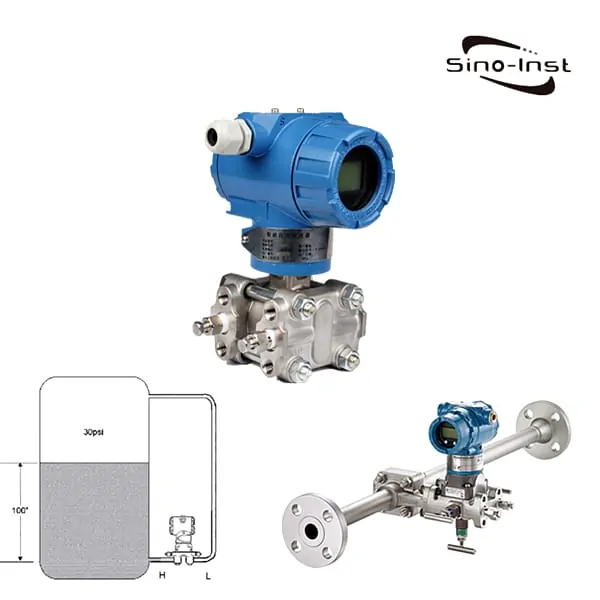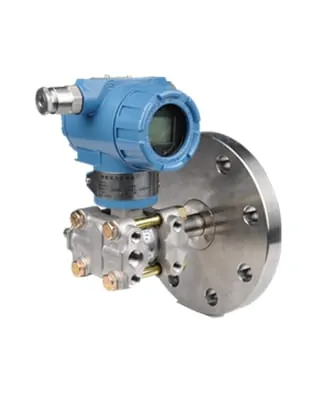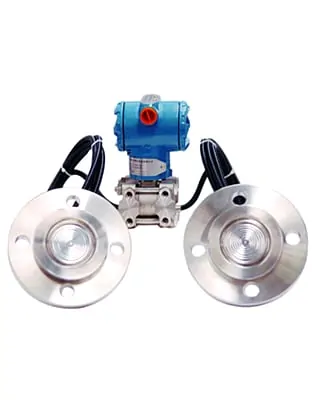Differential pressure transmitter installation guide helps you solve the installation problem of DP Transmitters.

Differential pressure transmitter is widely used in industrial differential pressure, liquid level, flow measurement. DP transmitters are often used with capillaries, orifices, 3 way manifolds, etc. After purchasing the smart differential pressure transmitter, the most concern is installation and debugging. Sino-Inst will share the Differential Pressure Transmitter Installation Guide with you below.
Sino-Inst offers a variety of differential pressure transmitters for pressure/level/flow measurement. If you have any questions, please contact our sales engineers.
Featured DP Transmitters

Piezoresistive Differential Pressure Transmitter utilizes the piezoresistive effect of semiconductor silicon materials. Realize accurate measurement of differential pressure.

Smart Differential Pressure Transmitter measures industrial differential pressure. Can Works with diaphragm seals, capillary, HART. Outputs standard signals (such as 4 ~ 20mA, 0 ~ 5V).

Flange Mounted Differential Pressure Transmitter is also called single flange DP level transmitter. For liquid, gas or vapor pressure measurement.

Extended Diaphragm Seal DP Transmitter is a level transmitter direct mounted on pipe or tank. The isolation diaphragm is in direct contact with the liquid medium.

Remote Seal DP Transmitter is often used as a tank level transmitter. The smart pressure transmitter is connected with a stainless steel flange by capillary. The pressure is sensed by a remote transmission device installed on a pipe or container.

Differential pressure (DP) level transmitter is a perfect solution for tank level measurement. Flanges, seal diaphragms, capillaries, and DP transmitter are often used to measure liquid levels.
Working principle of differential pressure transmitter:
The two pressures of the measured medium of the pressure transmitter pass into the high and low pressure chambers. Act on the isolation diaphragm on both sides of the delta element (ie the sensitive element). The filling liquid in the spacer and the element is transferred to both sides of the measuring diaphragm. The electrodes on the measuring diaphragm and the insulating plates on both sides each form a capacitor.
When the pressures on both sides are inconsistent, the measurement diaphragm will be displaced. The displacement is proportional to the pressure difference. Therefore, the capacitance on both sides is not equal. Through the oscillation and demodulation link, it is converted into a signal proportional to the pressure. The working principle of pressure transmitter and absolute pressure transmitter is the same as that of differential pressure transmitter. The difference is that the low pressure chamber pressure is atmospheric pressure or vacuum.
The A/D converter converts the current of the demodulator into a digital signal, whose value is used by the microprocessor to determine the input pressure value. The microprocessor controls the work of the transmitter. In addition, it performs sensor linearization. Reset the measurement range. Engineering unit conversion, damping, square extraction, sensor fine-tuning and other operations, as well as diagnosis and digital communication.
The D/A converter fine-tunes the data with the corrected digital signal from the microprocessor. These data can be modified by the transmitter software. The data is stored in the EEPROM, even if the power is off, it is kept intact.
The digital communication line provides a connection interface for the transmitter and external equipment. This circuit detects the digital signal superimposed on the 4-20mA signal and transmits the required information through the loop.
For more about the working principle of differential pressure transmitter, please refer to “Differential Pressure Transmitters”.
You may like: How does a pressure transmitter work?
Installation method of differential pressure transmitter:
- Direct pipeline installation. This installation method is simple and uses less materials.
- Flange installation. Mainly used in liquid level measurement. Use the static pressure of the liquid to measure the liquid level.
- Bracket installation (tube-mounted flat bracket). This type of installation is mostly adopted, which is convenient for installation and maintenance. In the past, the instrument box was used in the open air to protect the intelligent differential pressure transmitter from dust and rain. But the protection of the current smart differential pressure transmitter is very good. The protection grade is IP65, the working environment temperature is -40~+75℃, vibration resistance, dustproof, rainproof, maintenance-free for 5 years.

Extended reading: Smart Differential Pressure Transmitter
Differential Pressure Transmitter Installation Guide
Initial state: all valves are in the closed position
- Open the two primary doors on the positive and negative pressure side
- Open the balance valve
- Wait for the steam in the pressure line and the condensate container to condense
- Open the secondary door on the positive pressure side and the drain screw of the positive measurement chamber until the condensate without air is discharged
- Close the drain screw of the positive measurement chamber
- Turn on the drain screw of the negative measurement chamber until the condensate without air is discharged
- Close the secondary door on the positive pressure side
- Open the secondary door on the negative pressure side until the condensate that does not contain air is discharged from the drain screw of the negative measurement chamber
- Close the drain screw of the negative measurement chamber
- Close the negative secondary door
- Open the secondary door on the positive pressure side again
- Check for leakage and check the zero point of the instrument
- Close the balance gate
- Fully open the secondary door on the positive and negative pressure side.

Reason: drain the pipeline and the air in the measurement room to reduce errors
Protect the transmitter so that the differential pressure on the positive and negative pressure sides is appropriate.
The input should be to open the positive pressure side first (slowly), then close the balance door, then open the negative pressure side, and finally ensure that the positive and negative sides are fully open and the balance door is closed.
Because if you open both the positive and negative sides, the pressure on the positive side is greater than the negative side, because the balance door is open at that time. In that way, the condensate on the positive pressure side will flow back into the negative pressure pipe, and the pipe will have steam and generate heat, which will damage the transmitter.
Read more about: What is industrial pressure transmitter?
Operating Regulations of Differential Pressure Transmitter
- The range adjustment and check accuracy of the differential pressure transmitter should be carried out behind the indoor panel using a handheld communicator, and must not be operated on site with power.
- After adjusting the range, the differential pressure transmitter should be calibrated. The process is as follows:
Open the balance valve, first close the low-pressure side inlet valve, then close the high-pressure side inlet valve, and open the high-low pressure side exhaust valve. At this time, the computer displays zero.
Correctly connect the process tester, differential pressure module, and hand-operated pump to the exhaust hole of the high-pressure end, and close the balance valve.
Adjust the pressure to half of the range and full range respectively. At the same time, observe whether the data change at this point is consistent with the range on the indoor computer.
Remove the calibration instrument, close the exhaust hole, open the balance valve, open the high-pressure side inlet valve, open the low-pressure side inlet valve, and slowly close the balance valve. - If the differential pressure transmitter must be disassembled, the following requirements should be strictly followed.
Turn off the power of the differential pressure transmitter and confirm that it is correct.
Open the balance valve, first close the low pressure side inlet valve, then close the high pressure side inlet valve, and open the high and low pressure side exhaust valve.
Close the intake valve on the orifice side.
Open the differential pressure transmitter wiring terminal, remove the meter wiring, write down the wiring sequence, and pull out the meter wiring.
Remove the transmitter.
Wrap the plastic bag of the pressure tapping hole tube with the head of the explosion-proof hose facing down to prevent water from entering.
In short, I hope everyone will take a look at the installation diagram of the smart differential pressure transmitter before putting it into operation. This way, I know it. The Differential Pressure Transmitter Installation Guide introduced in this article is suitable for smart differential pressure transmitters produced in China. The same applies to brands such as Rosemount.
If you have any questions about differential pressure transmitters, please contact our sales engineers.
Extended reading: How to calibrate HART pressure transmitters
You may like:
Read more What is a diaphragm seal?
Sino-Inst is a Differential pressure transmitter manufacturer. We provide more than 20 kinds of differential pressure transmitters. Including flange differential pressure level transmitter. Capillary diaphragm differential pressure transmitter, etc. Differential pressure transmitters are also used in the measurement of flow, liquid level, density, etc.
Differential Pressure Transmitter Installation Guide is a simple guide we provide you. If you encounter problems when installing the differential pressure transmitter, please feel free to contact our engineers.

Wu Peng, born in 1980, is a highly respected and accomplished male engineer with extensive experience in the field of automation. With over 20 years of industry experience, Wu has made significant contributions to both academia and engineering projects.
Throughout his career, Wu Peng has participated in numerous national and international engineering projects. Some of his most notable projects include the development of an intelligent control system for oil refineries, the design of a cutting-edge distributed control system for petrochemical plants, and the optimization of control algorithms for natural gas pipelines.
